Equation, Definition, Theorem, Proof, Example, Solution, Types - Ellipse | 12th Mathematics : UNIT 5 : Two Dimensional Analytical Geometry II
Chapter: 12th Mathematics : UNIT 5 : Two Dimensional Analytical Geometry II
Ellipse
Ellipse
We invoke that an ellipse is the locus of a point which moves
such that its distance from a fixed point (focus) bears a constant ratio
(eccentricity) less than unity its distance from its directrix bearing a
constant ratio e (0 < e < 1) .
(i) Equation of an Ellipse in standard form
Let S be a focus, l be a directrix, e be the
eccentricity (
0 < e < 1) and P(x, y) be the moving point.
Draw SZ and
PM perpendicular to l
.

Let A and A′ be the points which divide SZ internally
and externally in the ratio e :1 respectively. Let AA′ = 2a .
Let the point of intersection of the perpendicular bisector with AA′ be C.
Therefore CA = a and CA′ = a. Choose C as
origin and CZ produced as x -axis and the perpendicular bisector
of AA′ produced as y –axis.
By definition,
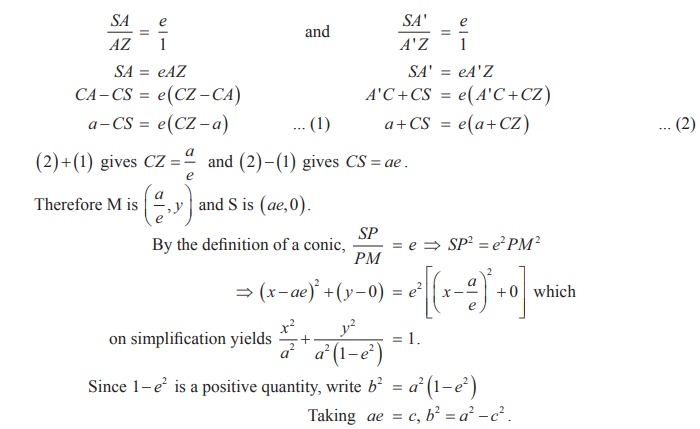
Hence we obtain the locus of P as  which is the equation
of an ellipse
in standard
form and note that it is
symmetrical about x and y axis.
which is the equation
of an ellipse
in standard
form and note that it is
symmetrical about x and y axis.
Definition 5.4
(1) The line segment AA¢ is called the major axis of the ellipse and is of length 2a .
(2) The line segment BB¢ is called the minor axis of the ellipse and is of length 2b .
(3) The line segment CA = the line segment CA¢ = semi major axis = a and the line segment CB = the line segment CB¢ = semi minor axis = b.
(4) By symmetry, taking S¢(-ae, 0) as focus and x =- a/e as directrix l¢ gives the same ellipse.
Thus, we see that an ellipse has two foci, S (ae,
0) and S¢(-ae, 0) and
two vertices A(a, 0) and A¢(-a, 0) and
also two directrices, x = a/e and x =- a/e.
Example 5.15
Find the length of Latus rectum of the ellipse 
Solution
The Latus rectum LL’ (Fig. 5.22) of an ellipse  passes through S (ae, 0) .
passes through S (ae, 0) .
Hence L is (ae, y1
) .
Therefore,
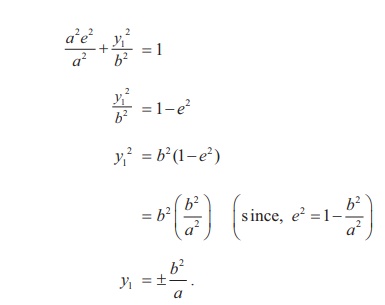
That is, the end points of Latus rectum L and L′ are 
Hence the length of latus rectum LL' = 2b2 / a
(iii) Types of ellipses with centre at (h, k )
(a) Major axis parallel to the x-axis
From Fig. 5.24

The length of the major axis is 2a . The length of the minor axis is 2b . The coordinates of the vertices are (h + a, k ) and (h − a, k ) , and the coordinates of the foci are (h + c, k ) and (h − c, k ) where c2 = a2 − b2.
(b) Major axis parallel to the y-axis
From Fig. 5.25

The length of the major axis is 2a . The length of the minor axis is 2b. The coordinates of the vertices are (h, k + a) and (h, k – a) , and
the coordinates of the foci are (h, k + c) and (h, k – c) , where c2
= a2 - b2 .
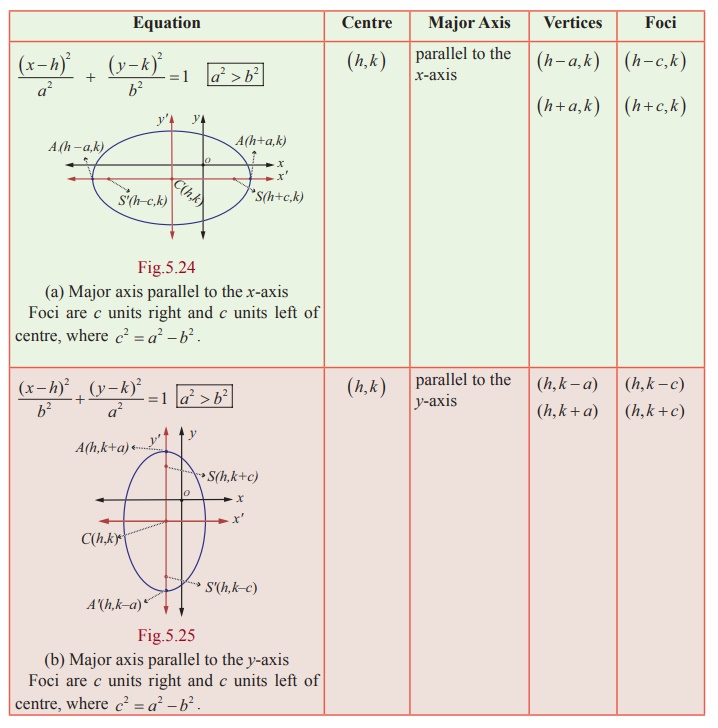
Theorem 5.5
The sum of the focal distances of any point on the ellipse is
equal to length of the major axis.
Proof
Let P(x, y) be a point on the ellipse 
Draw MM ¢ through P perpendicular
to directrices l and
l¢ .

Draw PN ^ to x -axis.
By definition SP = ePM
= eNZ
= e[CZ - CN ]
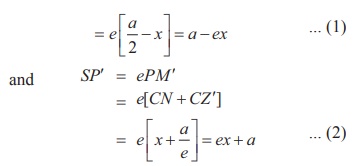
Hence, SP + S¢P = a - ex + a + ex = 2a
Remark
When b = a , the equation  = 1, becomes (x - h)2
+ ( y - k )2
= a2 the equation of circle with centre (h, k) and radius a .
= 1, becomes (x - h)2
+ ( y - k )2
= a2 the equation of circle with centre (h, k) and radius a .
When b = a, e =  = 0 . Hence the eccentricity
of the circle is zero.
= 0 . Hence the eccentricity
of the circle is zero.
Furthere, SP/ PM = 0 implies PM →∞ . That
is, the directrix of the circle is at infinity.
Remark
Auxiliary circle or
circumcircle is the circle with length of major axis as diameter and Incircle is the circle with length of minor axis as diameter. They are given by x2 + y2 = a2 and x2 + y2 = b2 respectively.
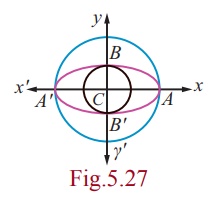
Related Topics